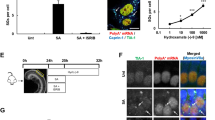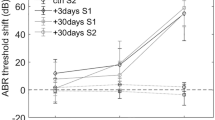Abstract
All aminoglycoside antibiotics in clinical use are ototoxic in that they can cause permanent malfunctioning of the cochlea and vestibule1–3. It is generally assumed that these ototoxic antibiotics primarily affect the sensory hair cells in the inner ear and that degeneration of secretory and neural elements comes later2–5. Most experimental work on aminoglycoside antibiotic ototoxicity has concentrated on the irreversible effects on inner ear functioning and hair cell morphology2,3. Little is known about their mode of action on the hair cells. Interference with hair cell protein synthesis, in analogy with the antimicrobial mechanism, has been ruled out as the primary cause of the high selective6 toxicity of the aminoglycosides3,5. Recent evidence indicates that these antibiotics may interfere with membrane phos-pholipid metabolism7. Morphological studies have demonstrated that early on in the ototoxic process the membrane of the sensory hairs is already damaged4. The aminoglycoside antibiotics are reported to have a direct and reversible8,9 effect on hair cell functioning in organs of the acoustico-lateralis system of lower vertebrates8–11. Hence, the primary site of action is probably the hair cell membrane. We have now therefore examined reversible effects of ototoxic antibiotics on single fibre afferent nerve activity and extracellular receptor potentials in the lateral-line organ of Xenopus laevis. Our results show that the antibiotics, in concentrations similar to those measured in the cochlear fluids3, have a dual action on the hair cells. They not only increase the spontaneous afferent nerve activity, probably by an effect on the hair cell membrane, but also severely impair the mechano-electric transduction process, resulting in a large phase lag of the receptor potentials. The latter effect, which is antagonised by Ca2+ may be due to interference of the antibiotics with the mechanical properties of the sensory hairs.
This is a preview of subscription content, access via your institution
Access options
Subscribe to this journal
Receive 51 print issues and online access
$199.00 per year
only $3.90 per issue
Buy this article
- Purchase on Springer Link
- Instant access to full article PDF
Prices may be subject to local taxes which are calculated during checkout
Similar content being viewed by others
References
Weinstein, L. in The Pharmacological Basis of Therapeutics(eds Goodman, L. S. & Gilman, A.) 1167–1182 (Macmillan, New York, 1975).
Hawkins, J. E. Jr in Handbook of Sensory Physiology Vol.3 (eds Keidel, W. D. & Neff, W. D.) 707–748 (Springer, New York, 1976).
Brown, R. D. & Feldman, A. M. A. Rev. Pharmac. Tox. 18, 233–252 (1978).
Wersäll, J., Björkroth, B., Flock, A. & Lundquist, P.-G. Adv. Oto-Rhino-Laryngol. 20, 14–41 (1973).
Ylikoski, J. thesis, Univ. Helsinki (1975).
Fox, K. E. & Brummett, R. E. Acta oto-lar. 87, 72–78 (1979).
Schacht, J. J. acoust. Soc. Am. 59, 940–944 (1976).
Wersäll, J. & Flock, A. Life Sci. 3, 1151–1155 (1964).
Harada, Y., Musso, E. & Mira, E. Acta oto-lar. 64, 327–337 (1967).
Matsuura, S., Ikeda, K. & Furukawa, T. Jap. J. Physiol. 21, 579–590 (1971).
Gallais, A., Caston, J. & Zittoun, A. Acta oto-lar. 87, 517–527 (1979).
Kroese, A. B. A. van der Zalm, J. M. & van den Bercken, J. Pflügers Arch. ges. Physiol. 375, 167–175 (1978).
Kroese, A. B. A. van der Zalm, J. M. & van den Bercken, J. J. exp. Biol. (in the press).
Russell, I. J. J. exp. Biol. 54, 643–658 (1971).
Brown, R. D. & Daigneault, E. A. Acta oto-lar. 76, 128–135 (1973).
Dretchen, K. L., Sokoll, M. D., Gergis, S. D. & Long, J. P. Eur. J. Pharmac. 22, 10–16 (1973).
Prado, W. A., Corrado, A. P. & Marseillan, R. F. Archs int. Pharmacodyn. Thér. 231, 297–307 (1978).
Molgó, J., Lemeignan, M., Uchiyama, T. & Lechat, P. Eur. J. Pharmac. 57, 93–97 (1979).
Pittinger, C. & Adamson, R. A. Rev. Pharmac. 12, 169–184 (1972).
Diecke, F. P. J., Westecker, M. E. & Vogt, R. Archs int. Pharmacodyn. Thér. 193, 5–13 (1971).
Sanders Jr., W. E. & Sanders, C. C. A. Rev. Pharmac. Tox. 19, 53–83 (1979).
Sand, O. J. comp. Physiol. 102, 27–42 (1975).
Tanaka, Y., Asanuma, A. & Yanagisawa, K. Proc. Japan Acad. 55B, 31–36 (1979).
Russell, I. J. & Sellick, P. M. J. Physiol. Lond. 257, 245–255 (1976).
Valli, P., Zucca, G. & Casella, C. Acta oto-lar. 84, 344–351 (1977).
Flock, A., Flock, B. & Murray, E. Acta oto-lar. 83, 85–91 (1977).
Flock, A. & Cheung, H. C. Cell Biol. 75, 339–343 (1977).
Author information
Authors and Affiliations
Rights and permissions
About this article
Cite this article
Kroese, A., van den Bercken, J. Dual action of ototoxic antibiotics on sensory hair cells. Nature 283, 395–397 (1980). https://doi.org/10.1038/283395a0
Received:
Accepted:
Issue Date:
DOI: https://doi.org/10.1038/283395a0
Comments
By submitting a comment you agree to abide by our Terms and Community Guidelines. If you find something abusive or that does not comply with our terms or guidelines please flag it as inappropriate.



